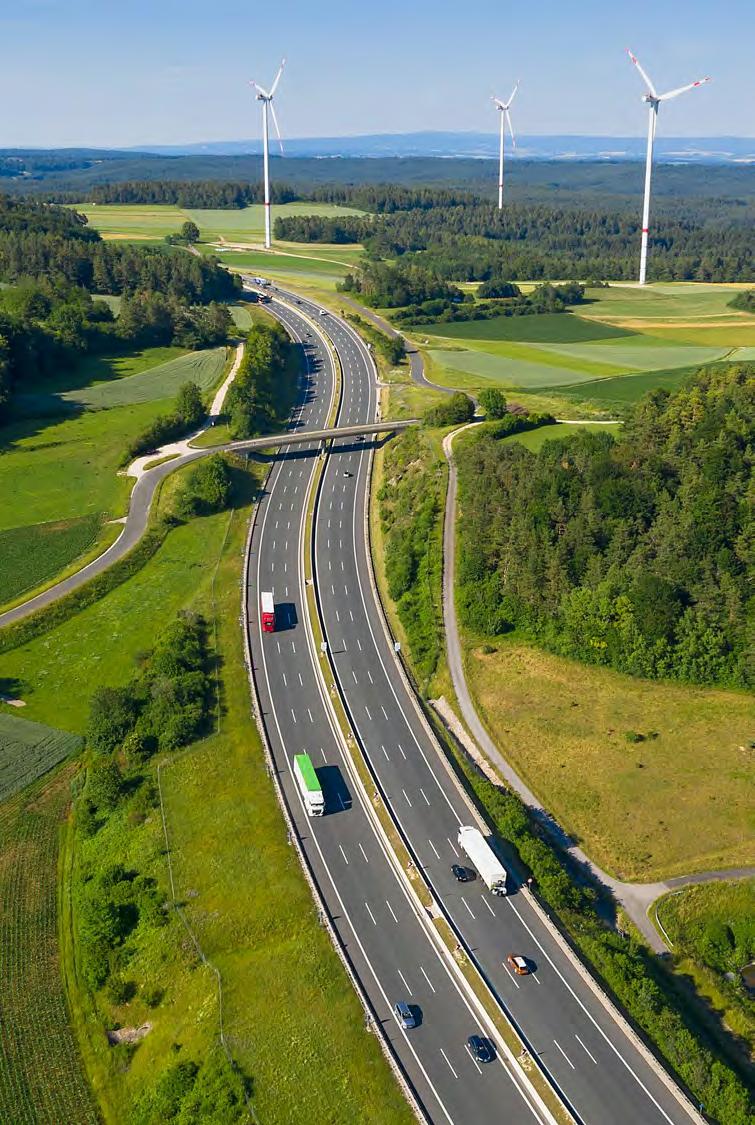




Since 2020, business has changed in ways we never would have imagined. Distribution businesses must adapt fast—and keep adapting. Private fleets that have yet to modernize and digitize their delivery operations may find it difficult to achieve the agility and flexibility needed to compete, much less survive.
This eBook looks at 10 trends that will have a profound impact on truck fleet management in the next few years—and the digital transformation your transportation planning and dispatch operations must undergo to prepare your business.
Freight transportation makes up 8% of global greenhouse gas emissions (GHGs), according to MIT’s Climate Portal. By 2050, freight is predicted to become the highest emitting energy sector— unless things change.

Pressure to go green is intensifying from all corners. Therefore, distributors must alter the way they operate as new, more sustainable regulations take effect.
You’ll run more electric vehicles (EVs).
A Wakefield Research Study of 300 fleet managers found that 90% believe EVs are the inevitable future of commercial fleets.
You’ll deal with more Low Emission Zones (LEZs).
LEZs are here and coming soon to a city near you. Greater London has one of the world’s largest LEZs, where medium- and heavyduty commercial vehicles that don’t meet a minimum emissions standard pay a daily charge to drive within the zone.
You’ll have to prove your green credentials. Many companies will require tangible proof of your green freight strategies and results before they will do business with you.
the Future – Are you ready for what’s next?
If fleet managers are ill-equipped to manage such changes, they will leave their companies vulnerable. You’ll need route optimization software with advanced functionality to support the following CO2-friendly features:
Consume less fuel.
Complex algorithms help to create highly efficient route plans that eliminate unnecessary miles from truck routes.

Manage mileage limitations.
Route plans can factor vehicle range into route calculations, as well as recharging times for EVs.
Provide customers with green delivery options.
For example, consumers arranging home delivery can receive an automated message during an online purchase process of the days and times when a truck will be in their neighborhood for a green-friendly delivery.
The introduction of sustainability factors makes truck fleet management even more complicated than it already is. The right software can help you manage this complexity and, more importantly, use it to gain a competitive advantage.
It’s time for lean and mean to be replaced by lean and green.
There are not enough drivers to meet the current market demand for freight transportation. The American Trucking Association puts the current shortfall of truck drivers in the US at 80,000. Analysts predict that shortfall will grow to 160,000 by 2030 if the current trend continues.
The driver shortage is the number one concern for fleet operators, according to an ATRI truck industry survey. It’s held that top spot in the annual survey for many years.
To handle this truck fleet management challenge, companies need to do two things: 1) satisfy delivery demands with fewer drivers or 2) keep the drivers they have. The right technology can help you do both.

Let’s start with reducing the ratio of total delivery stops to drivers. If your business still uses manual or basic technology to plan delivery routes, you’re driving 10–30% more miles than you should. Driving more miles leads to fewer stops on each delivery route, which means you will ultimately need more drivers. However, routing software can quickly put your fleet on a truck-mile diet, with powerful algorithms that examine the dozens of variables that impact route choices. Within minutes, the software can kick out optimized routes that allow you to cover more stops with fewer drivers. That’s a huge financial advantage.
For a 50-truck fleet running 3 million miles a year, a 20% mileage reduction will save $8.7 million, based on the National Private Truck Council’s operating-cost-per-mile estimate for trucks of $2.90. Driver-related costs alone account for half of that total savings. That’s $4.35 million you could save, simply by doing more deliveries per driver!
– Are you ready for what’s next?
Reducing the number of drivers you need is critical. Even more vital is keeping the drivers you have—especially when you consider that replacing just one driver can cost your business up to $15,000 in replacement and missed opportunity costs, according to FleetCardsUSA.
Here are just a few of the ways advanced route optimization software can help create happier drivers that stay:
Keep track of HoS limits to avoid compliance violations.
Data from in-cab electronic logging devices (ELDs) is fed directly into the route planning software, which then assigns only compliant routes. Drivers face personal fines for HoS violations, so it’s a worry they can do without.

A driver may prefer certain shift and break times, or even a particular truck. Or they may need to get off early on Thursdays to pick up a child from school. Advanced routing software with resource management functionality incorporates these preferences when creating route plans.
Software-aided route plans are more realistic and achievable because they factor in things that wreak havoc on delivery schedules, like traffic, road restrictions, and long unloading times at particular delivery sites. As a result, drivers are on-time for their most important appointment of the day—dinner with the family.
As the driver shortfall worsens, it’s vital for distribution businesses to attract and retain quality drivers. You'll achieve that goal faster and easier with the right tools.
About 4 billion people now live in cities—that’s more than half the world’s population. These cities produce 70% of global GHGs. According to the World Economic Forum, the rise in ecommerce delivery will result in 26% more delivery vehicles in inner cities by 2030, increasing emissions and traffic congestion.
City governments are aggressively moving to curtail congestion, and thereby improve air quality and the health of city dwellers. As city commissioners enact tougher municipal regulations, these new rules will have major implications for truck fleet management and how goods are delivered.

Low Emission Zones are one example of such regulation. With LEZs, city access can be limited only to CO2-friendly vehicles, like EVs. Another example is delivery microhubs. Located just outside urban areas, these cross-dock facilities receive deliveries from different trucks and transfer the goods onto green vehicles for final delivery. Today, dozens of distributors make their own daily deliveries across a city, adding to pollution and congestion. Tomorrow, they will all deliver to one consolidation point and work out who does the final run, including cost and time implications. While this emerging model is good for the environment, it adds a level of delivery complexity that fleet operators will need to manage.
Changes like this are more revolutionary than evolutionary. If you’re trying to manage such change without the benefit of smart software, the task could be insurmountable.
Here are some of the ways advanced route optimization tools can help you manage these new traffic and pollution mitigation measures:

Allow Low Emission Zones to be stored within the software. The software flags all deliveries that fall within LEZs and builds plans with proper vehicle assignments, like assigning an EV to the delivery or directing the use of third-party providers.
Route vehicles around dense traffic areas.
Advanced software understands historical traffic patterns and lets you automatically optimize routes for reduction of time, rather than miles. According to cost-of-congestion data from the American Transportation Research Institute (ATRI), a truck running 75,000 miles a year will cost about $20,000 more to operate annually due to congestion. For a 50-truck fleet, that’s $1 million in lost profits.
Leverage detailed mapping data.
Street-level mapping factors in all the routing details typical of cities, like alleyways, one-way streets or left/right turn restrictions. Having this level of nuance can save many hours of time—keeping drivers productive, not exasperated.
Gridlocked, pollution-ravaged cities are taking bold action now to make their streets more livable. They won’t wait for delivery technology to catch up, so make sure your tools have the functionality to manage future traffic mitigation measures.
When it comes to two-man, in-home delivery of appliances, furniture and other large items, consumers increasingly want to choose the day and time. And they prefer to arrange it themselves during the purchase process.

If you think that doesn’t apply to you because your deliveries are “B2B,” think again. In a post-COVID world, business models are changing. For instance, food distributors that once delivered exclusively to restaurants and retailers now deliver directly to homes.
By 2025, a self-service ability to choose delivery times will be fully entrenched in home delivery operations and gaining traction in B2B. The key for truck fleet management, in both B2C and B2B deliveries, is to enable customer choice, while still maintaining operational efficiency.
Advanced routing software can help by shaping delivery demand on certain days. Here’s how:
Delivery software for home deliveries is integrated with your commerce platform and, after every scheduled delivery, it re-spins the route plan for the entire delivery network, constantly reshaping routes. The system always knows what trucks will be in what areas during specific days and times. For consumers with addresses in these areas, you can flag those days/times on the delivery calendar as being eco-friendly or eligible for a delivery discount.
Consumers still get to choose from a flexible schedule of dates, but only from options that work best for your bottom line.
Going forward, your brand’s market share will rely far less on product and price, and far more on the quality of the delivery experience. That adds pressure on you as a fleet manager, but it’s also an opportunity to spotlight how transportation operations can be a catalyst for business success. Tomorrow’s customer will buy from brands that adapt delivery operations to meet their schedule, not the other way around.
Future – Are you ready for what’s next?
Real-time visibility has become a requirement for scheduled home deliveries—and the expectations of B2B customers are not far behind.
The days of consumers sitting at home waiting for a delivery earmarked for “Thursday afternoon” are over. Today, they want to pick a two-hour time window and then check delivery status themselves on a mobile device. Tomorrow, they’ll require an even more precise time window, or they’ll take their business elsewhere.
Advanced home delivery software with electronic proof of delivery (ePOD) functionality can help meet these expectations with capabilities such as these:
› Real-time consumer tracking of delivery status from a computer, tablet or smartphone, which increases the chance of first-time delivery success.
› Day-of-delivery email or text updates from the driver—“see you in 30 minutes.”
› Track My Driver functionality that lets consumers follow the driver’s en route progress.

All this specialized functionality can be integrated with your commerce platform and provided as a branded service.
B2B customer delivery expectations aren’t quite as demanding as those for home delivery, but they’re getting that way. By 2025, committing to specific delivery times won’t be optional. Unfortunately, many distributors just aren’t there yet. Drivers leave the terminal in the morning with a time-based schedule, but visibility is lost the moment they leave the yard.
You need routing and scheduling software that connects with the telematics systems in each of your trucks to provide live access to delivery status. This level of visibility allows you to continually compare planned-versus-actual route performance and make adjustments, as needed.
B2B customers want reliable ETAs so they can plan labor in advance to unload deliveries quickly and efficiently. The right software will also automatically push out exception alerts that notify them of delays.

In the future, your business will need visibility to its broader supply chain, beyond just the last mile. You’ll be expected to track supplier inventory as it moves inbound to the final-mile hub and outbound to customers. That will require one visibility platform, with real-time integration among multiple carrier systems.
Routing software with ePOD functionality is the tool that distribution businesses need to provide this level of comprehensive visibility. Such tools have become a necessity, rather than a nice to have.
– Are you ready for what’s next?
Today, most or all of the trucks in your fleet are powered by diesel fuel. However, that won’t be the case for long.

Biodiesel and liquified and compressed natural gas are gaining traction. By 2030, according to IHS Markit, battery-powered EVs will make up 14% of US new truck sales. Amazon said it will buy 100,000 EVs by 2025, while DHL, the world’s largest logistics company, has already migrated 20% of its global fleet to EVs.
In the UK, the government announced its intention to ban gas-powered vehicles by 2040. In the US, California and 15 other states will ban the sale of internal combustion engines starting in 2035.
So yes, green vehicles are in your future—whether it’s your choice or in response to a government mandate. And they have different capabilities that you’ll need to consider when creating delivery schedules, including limited range and downtime while charging.
You need to make sure you have software capable of incorporating the constraints of green vehicles into the route planning algorithm. More advanced systems will create route plans that restrict trip distances to the vehicle’s maximum range. If adjustments to the planned routes take mileage beyond the set range, the planners get an alert warning.
The right software also factors in vehicle availability. Because EVs that return from one route must have their batteries recharged, the software can factor in the time needed, and hold back the vehicle as an option for routes while it powers up.
Your route planning software must also be flexible enough to manage planning for fleets that comprise a mix of diesel-powered and green vehicles. This amps up the complexity as your fleet evolves to a new, sustainable standard.
Not all routing software has the functionality to handle the planning nuances of more sustainable trucks. As your fleet make-up changes, you might find that your route planning tools must change as well.
The smartest delivery plans can unravel once the driver leaves the terminal. But proactively addressing issues during a route can be difficult without the right tools. Often, all the driver carries with him is a sequenced stack of delivery orders. Other than that, he’s on his own and unconnected.
This is a problem, since delivery drivers are often the customer’s only interaction point with your brand. That moment of truth—the final delivery—is a distributor’s best opportunity to impress the customer. But most leave drivers ill-equipped for the task. In fact, consumers and businesses have more technology built into their doorbells than most drivers carry with them on a delivery run.
Going forward, this must change. The best way to do that is by empowering drivers with electronic proof of delivery solutions. Parcel carrier drivers carry ePOD devices with them to the front door when dropping off packages. The value of such technology goes far beyond confirming a delivery or getting electronic signatures.

Electronic proof of delivery has become an essential tool to win the customer experience battle through the following benefits:
Provide photographic evidence of proof of delivery.
By showing exactly where and when an item was delivered, you eliminate any disputes about non-delivery.
Facilitate day-of-delivery decisions.
Let’s say a customer is refusing a delivery due to a small scratch on an appliance. The driver can send a photo immediately to your customer service team and a price reduction can be negotiated on the spot to avoid stiff re-delivery costs.
You’ve probably experienced it. A delivery driver fumbling with a stack of paper orders and pulling out a crumpled sheet for signature. Consumers appreciate professional and tech-savvy delivery partners with sign-on-glass convenience.

Ensure delivery quality and consistency.
Customer-specific, in-home delivery procedures (wear shoe coverings, remove all boxes and packaging, etc.) can be held in the device to direct driver procedures. This increases customer satisfaction and makes the driver’s job easier.
For B2B deliveries, the ability to capture overages, shortages and damaged products, and then agree on a credit on the spot, leads to a clean invoice and faster cash reconciliation.
If such functionality is beyond what your current system can offer, it may be time for your company’s digital transformation to be
Truck drivers can be your best brand ambassadors—if you let them.
One lesson of COVID-19 as it relates to truck fleet management is that routing and scheduling software that can be accessed only from a corporate office puts your business at risk.
Looking forward, you’ll want anytime, anywhere access to your system, from any device. That means choosing routing software that is cloudbased or has both on-premise and Software as a Service (SaaS) versions.
With a cloud-based solution, route planners working from home can access all required functionality to plan and manage deliveries. Specific advantages of a cloud-based or hybrid option include the following:


Immediately address problems.
For instance, if a truck breakdown threatens subsequent deliveries, a planner can log on from anywhere to adjust routes and alert customers of any delays.
Manage multiple locations.
If your business runs discreet planning operations in multiple regions, cloud-based routing software gives you centralized access to data that may otherwise be housed at those different sites.
Reduce downtime.
For distributors, routing and scheduling software is the business’s core system. Any extended downtime can be catastrophic. Providers of cloudbased systems have more advanced reliability-assurance measures than in-house solutions.
Cloud platforms have a built-in solution for disaster recovery, automated updates, and continual performance monitoring.
If you plan to implement a cloud-based route optimization solution, you won’t be alone. About 85% of routing software implementations today are cloud-based or hybrid deployments, versus on-premise only.
– Are you ready for what’s next?
If demand for tighter delivery time windows is increasing among your B2B customers, hold on tight. These service level expectations will only increase.
The demand we’ve seen on the consumer side for fast, precisely timed deliveries is coming to B2B faster than you think. Why? Because the CEO signing your distribution agreement is the same consumer who just arranged an appliance delivery to her home between 2 and 3 pm next Thursday. They know it can be done, and they need that kind of predictability from their suppliers.
One reason is that, at most small businesses, workers wear many hats. Convenience stores, restaurants and school cafeterias don’t have people in charge of inventory and receiving. They have full-time cashiers and cooks and salespeople. Therefore, they must plan to receive deliveries and stock shelves using existing resources, with minimal disruption of day-to-day operations. For instance, the next-shift cashier may come in one to two hours early to unload a truck and stock shelves. But if the truck is late, you’re down a cashier, or left with three pallets of food sitting in the parking lot.
By 2025, distributors that can offer a reliable one- to two-hour delivery window will be the ones that win and keep business. If you don’t have the advanced route planning tools to deliver that degree of precision, then your foundational promise to customers as a distributor is wobbly.
The level of delivery precision your software can enable will depend on the sophistication of the algorithm used. Check out the accompanying list of route planning factors that, at a minimum, your software should consider. Basic software will not consider all these relevant factors.
In the distribution business, excuses for lateness—“Sorry, we hit rushhour traffic”—aren’t tolerated. Planning tools must anticipate and plan around predictable road conditions to provide ETA promises customers can rely on.

At the onset of the pandemic, distributors changed because they had to. Food wholesalers switched to home delivery when restaurants and hotels closed. Distilleries that made and distributed spirits to bars started making hand sanitizer and delivering it to hospitals.
Efficiency took a back seat to survival.
No one anticipated such scenarios, obviously. But, in theory, we could have. And that’s the enduring lesson of COVID-19 for truck fleet management. It’s less about reacting to change and more about anticipating change to make the operational response as efficient as possible.

That’s where strategic modeling of delivery routes comes in. If it’s not part of your toolset today, you’ll need it to prepare for the future pace of change.
Think of strategic transportation modeling as a highly sophisticated if/then calculator that allows you to determine the exact cost and service impact of potential distribution strategies. It takes all the detailed information on your distribution operation (customer delivery requirements, truck size and capacity, product weights and dimensions, DC locations, etc.) and allows you to ask just about any “what if” question you can think of—like “What if I added a DC?” or “What if I changed half my tractor-trailer fleet to box trucks?” or “What if I flex my delivery-time windows?”
what’s
You can apply this advanced modeling exercise to risk planning. Here are some examples of scenarios that more advanced route planning software could analyze so you’re anticipating change, not just reacting to it:
What if a major virus outbreak sidelined 20% of my drivers?
Routing software with resource management functionality can help manage quarantine periods and assign only eligible drivers to routes.

What if I have to shut down a distribution center?
Within minutes, a new plan could be created showing how all customers would be served from the remaining DCs, including precise schedules and costing.
What if I added a large new customer to existing routes?
Not all disruptive change is bad. You can use the modeling capability to overlay new delivery points over existing routes— before they are implemented—to make sure commitments you make to the new customer don’t erode your profits or decrease service levels for other customers.
Without the right tools, analyses such as these would take hours or days of number-crunching. Most distribution businesses can’t afford to redeploy transportation planners to such time-consuming tasks.
This barrier disappears with fleet routing software that can model new scenarios in minutes, once new variables are loaded in.
You may not be able to predict the future. But with the right tools you can anticipate what could happen and plan your response.
Future
Are you ready for what’s next?
For fleet managers, the challenges have never been greater.

Customers want deliveries faster, and at the exact time promised.
Ever-thinner profit margins are increasing board-level scrutiny of fleet operating costs—one of a distributor’s largest expense burdens.
Public-sector regulations to limit pollution and urban congestion are putting additional constraints on already complicated route plans.
All these trends have converged to make truck fleet management one of the most critical success factors for distribution businesses. It’s your job to figure it out, but that won’t be possible with old-school route planning processes that rely on spreadsheets and rudimentary tools. You’ll need Aptean’s advanced routing and scheduling software to compete and win.
The best time to plan for what’s next is now. You just need the right tools.
Contact us at info@aptean.com or visit www.aptean.com.

Aptean is one of the world’s leading providers of purpose-built, industry-specific software that helps manufacturers and distributors effectively run and grow their businesses. With both cloud and on-premise deployment options, Aptean’s products, services and unmatched expertise help businesses of all sizes to be Ready for What’s Next, Now®. Aptean is headquartered in Alpharetta, Georgia and has offices in North America, Europe and Asia-Pacific.
To learn more about Aptean and the markets we serve, visit www.aptean.com.